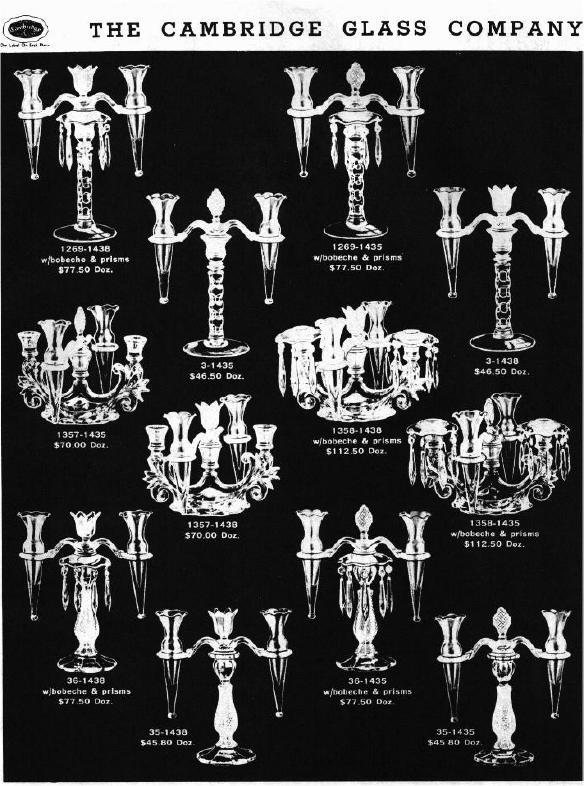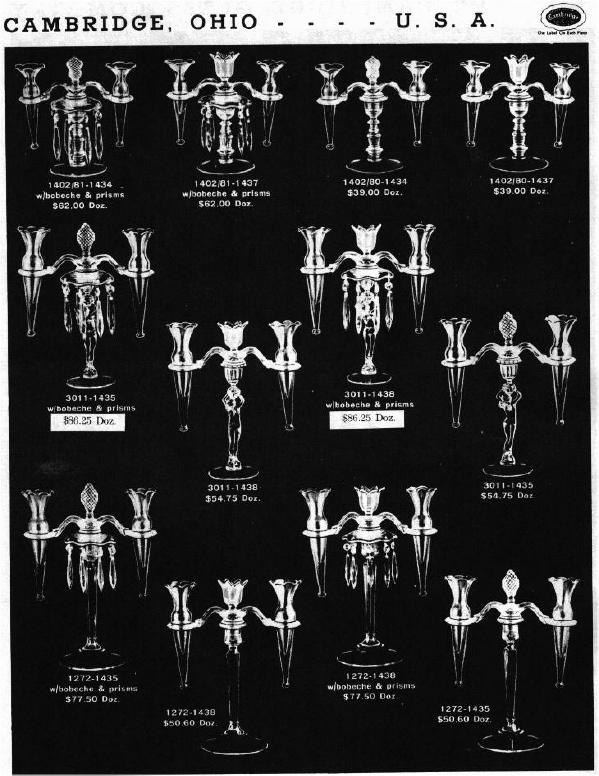Epergnes & Epergnettes, Part III
by Mark A. Nye
Issue No. 226 - February 1992
In Part II of this series on Epergnes, published in the November 1991 issue of the Cambridge Crystal Ball, the vase and candleholder arms #1436, #1437 and #1438 were discussed, as was the vase holder arm #1435. Mention was made of two other vase holder arms, but no specifics were given. Corresponding in size to the three vase and candle arms, the vase holder arms differ in that they lack the center candleholder; instead each of the three has a different style center knob.
Vase holder arm #1433, the smallest of the three with a width of 7¾", has a round knob in the center and corresponds to vase and candle arm #1436. (I hope to have an illustration of this arm available for reprint within the next few months.)
Vase holder arm #1434, corresponding in size to vase and candle arm #1437, is 9" wide and can be seen as part of the #1402/81-1434 and #1402/80-1434 epergnes.
The width of the #1435 vase holder arm is 10½", making it the largest of the three and it is equivalent in size to the #1438 vase and candleholder arm. There are several examples of epergnes using this arm, shown on the accompanying reprinted catalog pages, and all are identified by the presence of the number "1435" at the end of the item number that indicates the arm used. This same format holds true for all the epergnes shown with this article.
Use of vase holder arms #1433 and #1434 apparently ceased sometime between 1935, the year the catalog pages shown here were probably issued, and 1940, as they do not appear in the catalog issued that year.
Looking carefully at those epergnes with bobeches, pictured with this article, the observer will note that the bobeches appear to be reversed or upside down. The reason or reasons why Cambridge used the bobeches in this manner is not clear. One possible reason is that when the bobeche is used in the upright position in conjunction with certain candleholders, such as the #3011 or Nude candleholder, the arms would not fit properly. Another reason is that perhaps whoever was assembling the other epergnes prior to their use in preparing the catalog illustration (and an illustration in a national magazine) saw those that required the reversed bobeche and set them all up that way.
It does appear that the bobeche used in the inverted position is the regular #19. The #1441/8 epergne shown in the 1940 catalog (refer to the November 1991 issue for an illustration of this epergne) has reversed bobeches and in the price list are stated to be #19 bobeches. The #19 bobeche is shown extensively elsewhere in the upright position, thus demonstrating it can be used in either manner. However, use in the inverted position does require prisms to be rehung.
The top four epergnes on the first catalog page below, have as their base the Martha Washington #3 candlestick. (Note: The Martha Washington line was brought out in the mid-to-late 1920s as the Centennial line and in 1931 was known as the Victorian line. It wasn't until 1932 that it became known as Martha Washington.) With the addition of the bobeche collar, bobeche and prisms, this candlestick is known as the #1269. The Martha Washington #3 candlestick and its associated epergnes were discontinued prior to 1946.
Epergnes #1358-1438 and #1358-1435, shown in the middle of the first page below, were discussed in Part II. There, they were referred to by their later item numbers, #1358/8 and #1358/5, and were illustrated with the bobeche in an up-right position. The #1357-1435 and #1357-1438 epergnes lack bobeches and prisms, but otherwise are the same as the preceding two. All four epergnes use the #1357 3-light candlestick, dating to the early 1930s, as their base. (Remember that when bobeches were to be used, a collar was added to the basic candlestick.)
At the bottom of the same page (below) are seen four items that use the Mt. Vernon #35 8" candlestick as the basic unit. The Mt. Vernon #36 is simply the #35 with the addition of a bobeche collar, bobeche and prisms. The Mt. Vernon line was brought out in 1932 and by 1946 the bulk of the line, including the four epergnes shown here, had been discontinued.
Seen on the top row of the second page are four Tally-Ho epergnes base on the 6½" #1402/80 candlestick. In these illustrations, the #1402/81 candelabrum appears to differ from the #1402/80; however, the only difference is the addition of the bobeche collar, bobeche and prisms.
The #3011 Nude Figure Stem line candlesticks, complete with bobeche and prisms was shown in the October 1934 trade advertisement announcing the line's introduction. It is seen here, forming the basis for four epergnes, using arms #1435 and #1438.
The basic unit for the four epergnes whose numbers begin with #1272 is the #636 9½" candlestick, first seen as early as 1927. Addition of collar, bobeche and prisms turns this item into the #1272 10½" candlestick with luster cut prisms. As such, it was pictured on a supplemental page, issued in late 1930, to the 1930 catalog. At that time, the bobeche was shown upright and carried 10 prisms, thus being the #20 bobeche.
It is impossible to tell from these catalog reprints how many prisms there are on any of the items shown; and, unlike some other catalog pages Cambridge issued, the identity and quantity of the bobeche and prisms is not provided.
All twelve epergnes seen on the second page shown below, as well as the basic candlesticks, were out of the Cambridge line prior to 1946.


